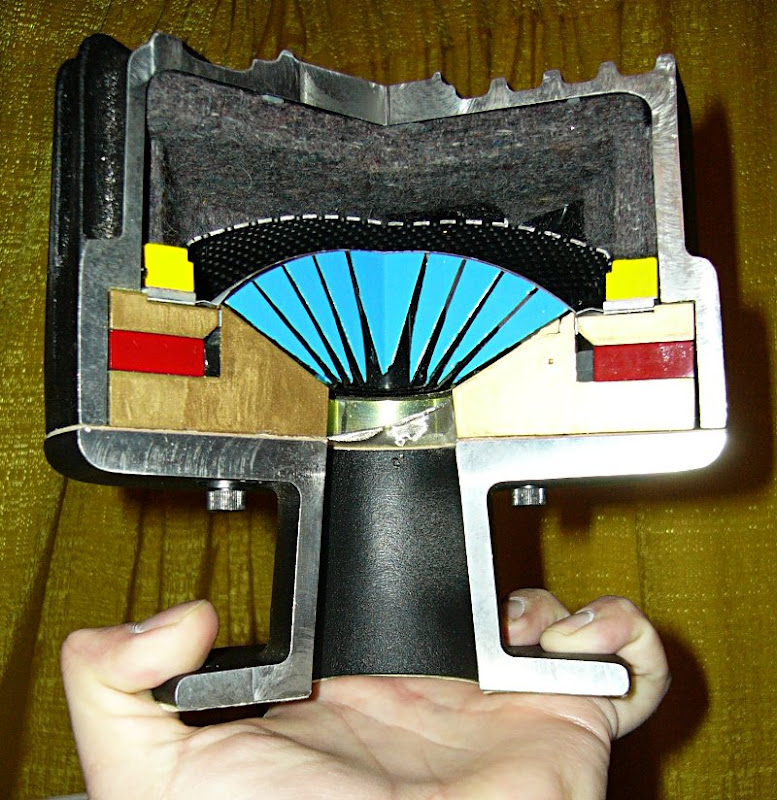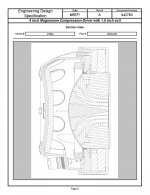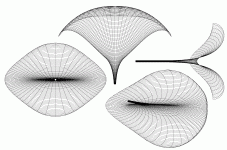The cross sectional area continues to expand from the throat diameter, the narrow diffraction slot allows dispersion to higher frequencies.

Interesting. So it's similar to what happens in the phase plug, where the width at the throat is smaller than the width at the diaphragm. But in the M2 they achieve a smaller throat while the expansion rate is still growing, because it expands on one axis (diagonally) while shrinking on the other (vertically and horizontally)
Thats what is interesting. why do it twice.
http://www.audioheritage.org/vbulletin/showthread.php?32378-H9800&p=327214&viewfull=1#post327214
http://www.audioheritage.org/vbulletin/showthread.php?32378-H9800&p=327214&viewfull=1#post327214
These are classsic Biradial with the usual warping to make them work as a flat front design. They have the usual straight sides curving to an end flare and as such are modified conical.The detail by the throat is just a small amount of diffraction slot (some versions such as the big theater horns and the 2344 have a deep diffraction slots, these are quite shallow but do the same thing). It just allows the lateral profile to be fed from a narrower starting dimension to maintain beamwidth to a higher frequency.
The big M2 horns look more like the Older EV white horns to me. They have the taller aspect ratio so that they can hold their beamwidth down to similar frequencies both horizontally and vertically, as per the first generation Manta Ray designs.
To understand these and any other CD designs you should read Don's EV and JBL papers, and the Altec Manta Ray paper. Then a lot of the profiles will make more sense.
Of course my horn knowledge is old and obsolete...
David S.
I know the last comment was tongue in cheek, but wanted to give you kudos for posting here on diayaudio. Back when I was in my 20s I was fascinated by your designs for Snell. And in my 30s I was doing some consulting for Disney, at their office across the street from the Seattle library. A great deal of my horn and waveguide knowledge stems from reading the AES papers they have there on microfiche. (You know you're a horn nut when you're idea of 'a fun time' is studying microfiche at the library.) That was where I discovered Geddes papers on OS waveguides and your papers on the eXpanding array.
Thats what is interesting. why do it twice.
H9800
IMHO, it's a way to have your cake and eat it too.
Let's say that you want to control polar response from 13,500hz and down. That's going to require a compression driver with a 1" throat. (13,500hz is 1" long.)
But the M2 has a 1.5" throat, and we'd 'normally' expect directivity to become uncontrolled above 9000hz. (Due to the 1.5" exit.)

So the beaks allow JBL to have their cake and eat it too. It allows a narrowing on the horizontal and the vertical axis, while still allowing the waveguide to expand on the diagonals. So the waveguide is still expanding, but the beamwidth is not... or at least it's not in the dimensions that we measure (left, right, up, down.)
I know the last comment was tongue in cheek, but wanted to give you kudos for posting here on diayaudio.
Thanks for mentioning it, and my pleasure!
David
I am trying to figure a way to make a clone. Possibly modeling clay.
On the topic of throat interaction, Lynn Olsen in his thread has put such an emphasis on matching the exit angle of the driver to eliminate early relections. I believe JMLC is the father of this notion, but could be very wrong. Its odd that JBL doesnt not seem to ascribe to this notion. Perhaps it is my misunderstanding and their choice is for a very specific reason as spelled out in the thread.
On the topic of throat interaction, Lynn Olsen in his thread has put such an emphasis on matching the exit angle of the driver to eliminate early relections. I believe JMLC is the father of this notion, but could be very wrong. Its odd that JBL doesnt not seem to ascribe to this notion. Perhaps it is my misunderstanding and their choice is for a very specific reason as spelled out in the thread.
I am trying to figure a way to make a clone. Possibly modeling clay.
On the topic of throat interaction, Lynn Olsen in his thread has put such an emphasis on matching the exit angle of the driver to eliminate early relections. I believe JMLC is the father of this notion, but could be very wrong. Its odd that JBL doesnt not seem to ascribe to this notion. Perhaps it is my misunderstanding and their choice is for a very specific reason as spelled out in the thread.
The entire point of the oblate spheroidal waveguide is to minimize diffraction while controlling directivity. The OS curve was born out of the need for directivity control without the diffraction of the Keele CD horns, which used a diffraction slot.
For instance, if you have a compression driver with an exit of 10 degrees, but a horn that's designed for a compression driver with an exit of zero degrees, you're going to get diffraction right at the throat.
Over the past few days I've been screwing around with Beolab style reflectors, and it's shocking how *anything* at the throat changes the polars and the frequency response across the entire frequency range. I'd always assumed that reflections at the throat would mostly affect the high frequencies, but I was wrong. It affects the entire bandwidth of the compression driver.
I first heard about matching the compression driver to the throat from Geddes, and it's a fundamental requirement for a proper OS curve. (If I'm not mistaken, I was there the day that Lynn Olsen met Geddes, and it was that meeting that inspired me to to buy the Summas. That was at the RMAF in 2005, and it was kind of amusing that only a handful of people seemed to appreciate how significant the Summas were! Constant directivity speakers don't sound like direct radiators, and a lot of people were put off because it takes a while to 'adjust' to the sound of CD.)
We have some serious heavyweights on this thread; Geddes practically wrote the book on waveguides, and Smith worked on horns at JBL. Plus a couple of little known companies named "Kef" and "Snell."
Its odd that JBL doesnt not seem to ascribe to this notion. Perhaps it is my misunderstanding and their choice is for a very specific reason as spelled out in the thread.
Almost all of the new 1.5" and 2" drivers are throatless using traditional domes and the coherent wave phase plug. There is nothing to match the phase plug is right up against the bug screen. Now the M2 compresion driver is completely different from a conventional dome compression driver because of the phase plug and the dual anular ring diaphrams .
The phase plug is not the traditional type more like multiple rectangular vents feeding a common chamber with a single solid phase plug at the output before the screen.
Attached is the 476Mg crossection
Rob🙂
Attachments
Last edited:
I would postulate that what we are looking at is not simply using a diffraction effect but a pressure manipulation, ie, we are changing the pressure distribution of the wavefront by the careful placement of these so called lips.
Very interesting discussion!
Jean-Michel, have you published a spreadsheet for these horn profile calculations?
What I really would like would be to be able to set an horizontal curve (such as an OS curve for example), a "global" profile (tractrix of a given frequency, etc.), and let the software calculate the whole shape of the horn, letting the vertical curves be what it ever it takes to obtain the global profile with the horizontal curve as a constraint)
Hello Pos,
Sorry for the delay to reply.
My spreadsheet needs the area of the wavefront at any distance from the throat. If you have a formula that gives you the area versus the distance to the throat and then your own requirements for a given property of the horn (e.g. horizontal profile = oblate spheroidal), then I can modify the spreadsheet to accord to that.
But if you don't know the exapnasion of the area versus distance to throat, my spreadsheet is not useful to you.
I agree with Wayne Parham when he says that a bad expansion law of the area of the wavefronts can increase diffraction (plus partial reflection of the wave). That's why despite some modern trend, I am still proponent of Webster's approach to obtain the most constant and resistive acoustical impedance of the horns I designed. Thus the need for the spreadsheet to oerate from a known exapnsion law of the area of the wavefronts, my own choice being the hyperbolic expansion law with T between 0,5 and 0,8 (with few exceptions for bass horns or horns for tweeters...).
Best regards from Paris, France
Jean-Michel Le Cléac'h
P.S. To New-Jersey or Massachusetts résidents : for a woman friend coming in France for several years I am looking for a free storage facilty in New-Jersey or Massachusetts for her stuff (including long board, telescope, baby Steinway piano...).
Hi Jean-Michel,
That is exactly what I am looking for: I have a compression driver with known T and frequency hypebolic expansion in the throat, and I would like a horn that would match this, but maintain a controlled directivity on the horizontal plan (and collapse on the vertical plan accordingly). I am leaning toward OS for the horizontal profile (with the proper starting angle that would match the throat exit angle). It would of course need some form of rounding at the mouth, ideally to meet a baffle at 180° (but the baffle could be arrange to suit the horn shape a bit...).
I have done calculations for a radial horn, and this results in a vertical profile that first shrinks (to compensate for the rapid initial expansion in the horizontal plan) and then grows again. This results in a slot and will give different acoustic centers on the horizontal and vertical plan...
That is exactly what I am looking for: I have a compression driver with known T and frequency hypebolic expansion in the throat, and I would like a horn that would match this, but maintain a controlled directivity on the horizontal plan (and collapse on the vertical plan accordingly). I am leaning toward OS for the horizontal profile (with the proper starting angle that would match the throat exit angle). It would of course need some form of rounding at the mouth, ideally to meet a baffle at 180° (but the baffle could be arrange to suit the horn shape a bit...).
I have done calculations for a radial horn, and this results in a vertical profile that first shrinks (to compensate for the rapid initial expansion in the horizontal plan) and then grows again. This results in a slot and will give different acoustic centers on the horizontal and vertical plan...
Hello Pos,
The oblate spheroidal profile doesn't allow the mouth to roll back for itself and my spreadsheet doesn't allow a mouth part to be added.
But there is a horn very similar to what you described I use to design many years ago. Too bad it was never built.
See attached 3D view graph.
Best regards from Paris, France
Jean-Michel Le Cléac'h
The oblate spheroidal profile doesn't allow the mouth to roll back for itself and my spreadsheet doesn't allow a mouth part to be added.
But there is a horn very similar to what you described I use to design many years ago. Too bad it was never built.
See attached 3D view graph.
Best regards from Paris, France
Jean-Michel Le Cléac'h
Attachments
POS,
The art of compromise is what is the true art of the design of horns and waveguides. It is possible to remove the dip that is so obvious in most radial horn designs but this will require a narrowing of the width at the same time if you stay with the hyperbolic expansion rate. You can not set a fixed vertical wall angle from the throat out and meet this requirement, so where do you compromise is the question? Is it more important to you to have a fixed horizontal wall angle or to eliminate the conjunction of the throat and flare of a typical radial horn. I think this has much to do with why so many have gone to the conic expansion rates, the ease of setting wall angle and optimum loading be damned. I truly appreciate what Jmmic has done with his designs it is a more elegant approach than many are willing or capable to achieve. This very area of a typical radial horn lens was what started me down the path of waveguide design since 1976 and is still something that I believe is a real test of design skills.
The art of compromise is what is the true art of the design of horns and waveguides. It is possible to remove the dip that is so obvious in most radial horn designs but this will require a narrowing of the width at the same time if you stay with the hyperbolic expansion rate. You can not set a fixed vertical wall angle from the throat out and meet this requirement, so where do you compromise is the question? Is it more important to you to have a fixed horizontal wall angle or to eliminate the conjunction of the throat and flare of a typical radial horn. I think this has much to do with why so many have gone to the conic expansion rates, the ease of setting wall angle and optimum loading be damned. I truly appreciate what Jmmic has done with his designs it is a more elegant approach than many are willing or capable to achieve. This very area of a typical radial horn lens was what started me down the path of waveguide design since 1976 and is still something that I believe is a real test of design skills.
Hello Pos,
The oblate spheroidal profile doesn't allow the mouth to roll back for itself ...
Best regards from Paris, France
Jean-Michel Le Cléac'h
That's not true. If you want to "roll back" the mouth then do so, the "OS profile" doesn't have a mouth and so it doesn't say anything about how to deal with it. I don't "roll back" the mouth because I believe that a radius into a flat baffle is the better termination. If my waveguides were free standing then I too would "roll back" the mouth.
Earl,
I completely agree about your statement about the rollback of a mounted waveguide on a baffle. It makes little sense to do that and then try to mount a rolled over horn onto a flat baffle. At the same time do you have a minimum radius value that you use to blend your waveguides into the baffle to have a smooth transition?
I completely agree about your statement about the rollback of a mounted waveguide on a baffle. It makes little sense to do that and then try to mount a rolled over horn onto a flat baffle. At the same time do you have a minimum radius value that you use to blend your waveguides into the baffle to have a smooth transition?
Earl,
I completely agree about your statement about the rollback of a mounted waveguide on a baffle. It makes little sense to do that and then try to mount a rolled over horn onto a flat baffle. At the same time do you have a minimum radius value that you use to blend your waveguides into the baffle to have a smooth transition?
I'd assume 1/4 W/L or thereabouts at the lowest frequency desired- so 3-4" on the bigguns and less on the smaller- the doc can validate my guess 😀
Use the largest radius that the design can afford. Larger is always better. I use 4" on 15" waveguides, 3" on 12", 2" on 10" and 8". I would liked to have used 4" on the Abbey, but that just widened the speaker by two inches which was more than I wanted to do.
How would changing the circumference of an Iwata 290 effect is output. It would be aesthetically convenient to use a larger circumference with its flatter face, similar to the JBL horn 9800.
http://www.geocities.jp/arai401204/Horn/A290/A290.html
http://www.audioheritage.org/vbulletin/attachment.php?attachmentid=54512&stc=1&d=1326930409
http://www.geocities.jp/arai401204/Horn/A290/A290.html
http://www.audioheritage.org/vbulletin/attachment.php?attachmentid=54512&stc=1&d=1326930409
Last edited:
How would changing the circumference of an Iwata 290 effect is output. It would be aesthetically convenient to use a larger circumference with its flatter face, similar to the JBL horn 9800.
Wood Horn
http://www.audioheritage.org/vbulletin/attachment.php?attachmentid=54512&stc=1&d=1326930409
Hello,
The Arai horn A290 is not an Iwata horn. It is more similar to the TAD TH4001 horn.
About the JBL 9800 horn, it is beautiful for sure but it has sharp edge at the mouth. May be this is a source of diffraction.
Best regards from Paris, France
Jean-Michel Le CLéac'h
P.S. To New-Jersey or Massachusetts résidents : for a woman friend coming in France for few years, I am looking for a free storage facilty in New-Jersey or Massachusetts to put her stuff in safe conditions (stuff including long board, telescope, baby Steinway piano...).
- Status
- Not open for further replies.
- Home
- Loudspeakers
- Multi-Way
- JBL horn?

